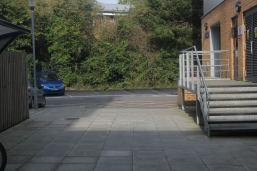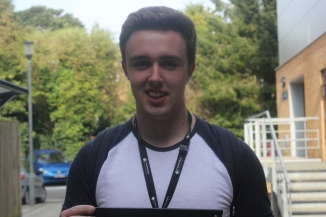Introduction
There are many different shots that are used in film and TV and as the platforms have progressed, so has the variety in framing and composition. In today’s world of media, particularly TV, it is extremely difficult to get the attention of an audience, even more so to keep it. This is why a variety of different shots are used to keep the audience engaged in the story. Using different, more creative shots also allows the director to tell a story in a different way which can also be very powerful when trying to keep the attention of the audience.
Task 1 – Framing Examples
During class we were shown different framing techniques and told how they can be used and how they are most effective. We were then asked to go and take pictures showing each example.
Shot Name: Dutch Angle
The Dutch angle otherwise known as the oblique angle, German angle and canted angle is often used to break apart a sequence of shots and to show that a character is confused or unaware of what is happening. To achieve the Dutch angle, the camera must be positioned at a slanted point and must not be tilted directly straight.

Shot Name: Establishment Shot
The establishment shot is used to give the audience a sense of location. In most cases it shows the location that the story is set in and does not show any of the main characters. The establishment shot is normally used at the start of a scene or when the location changes as that is when the audience needs to know where the story is taking place.

Shot Name: Long Shot
The long shot is used to capture a character or group of people from a distance. To achieve it, the entirety of the character/s body must be on screen.

Shot Name: Medium Long Shot
The medium long shot is used to capture a character or group of characters from a closer perspective. It is shot closer than a long shot but still further than a mid shot. This helps the director place the camera at the exact position and distance he/she wants it. To achieve it, the characters must only be visible above the knee.
Shot Name: Mid Shot
The mid shot shows the character/s from the waist and above. This is another shot that allows the director to place the camera at the desired position and distance.

Shot Name: Mid Close Up
The mid close up shot shows the character/s from the chest and above. Again this is another shot that allows the director to place the camera at the position and distance that is needed. This particular shot would normally only have 1 – 3 people in it as it would be difficult to make the shot not seem too busy.

Shot Name: Close Up
The close up shot shows just the characters face. This is because this kind of shot is used for switching between faces in conversation and to emphasize a subject for reasons that can vary to the story and situation.

Shot Names: Low Angle Shot and High Angle Shot
These two shots are extremely similar as they are used for almost the same purpose. A low shot would be used to make the subject seem bigger or superior to the audience. A high angle shot would have the opposite effect and would make the audience seem bigger than the subject.
Task 2 – Composition Examples
For this task we were asked to find images from films or TV shows that used the composition techniques that we had learnt about. In total there were six different techniques that were used for different reasons and results. The first technique that was shown was the rule of thirds. This is used to help give the subjects in the shot a good position and ensure that the area of focus can be seen clearly.
Symmetry gives a shot better aesthetic and is more attractive to a consumer to look at. It is mainly used to add emphasis towards a character or subject. Also it can be used to make the shot more interesting and keep the audience busy and more aware of what is happening.  (FilmShaun, 2013)
(FilmShaun, 2013)
Leading lines are used to draw attention to a subject. They are often effective when the subject is in the middle of the shot but they can also be used wherever the subject is. Similar to symmetry they can be used to give the image some more depth as there is more for the audience to decode.
![]() (Kim, 2015)
(Kim, 2015)
Depth can be used to make a shot more interesting by adding a background and a foreground. It helps the audience stay busy and remain engaged in the situation and story. It is extremely effective, however sometimes it can make a shot too busy and start to distract the audience. This is the opposite of what the director will be trying to achieve.
 (Wilson, no date)
(Wilson, no date)
Depth of field is very similar to depth however, depth of field also uses blur to distribute the focus and attention of the audience. It also makes the shot seem less busy therefore, not as distracting. However, to much use of depth of field in consecutive shots and seem tedious and could potentially lose the audiences attention.
 (DeSouza, 2011)
(DeSouza, 2011)
The last technique to help improve the composition of a shot is natural framing. Natural framing is the use of the environment or your surroundings to help shift the focus or the attention of your audience. In most cases, it is a frame around the shot that emphasizes the subject. Despite the name, it can be accomplished in both rural and urban environments.  (Somerholter, no date)
(Somerholter, no date)
Conclusion
To conclude there are many different ways that the quality of a shot can be effected by the framing or composition. Using a variety of different shot types and compositions will allow the Director to tell the story in a more engaging and fascinating way.
Bibliography:
cgdirector (2013) Learn how applying the. Available at: https://www.google.co.uk/url?sa=i&rct=j&q=&esrc=s&source=images&cd=&cad=rja&uact=8&ved=0ahUKEwiwlMXK1ajPAhVEPRQKHZPGAwgQjRwIBw&url=http%3A%2F%2Fwww.cgdirector.com%2Flearn-how-applying-the-rule-of-thirds-will-drastically-improve-your-renders%2F&psig=AFQjCNEW_txFMYo_BPcxF59ODF_Xfup6Gg&ust=1474829342564958 (Accessed: 24 September 2016).
DeSouza, C. (2011) Sony’s PMW F3 brings depth of field to Stereoscopic 3D movie making. Available at: https://www.google.co.uk/url?sa=i&rct=j&q=&esrc=s&source=images&cd=&cad=rja&uact=8&ved=0ahUKEwi1l6C32KjPAhXQzRoKHVdNAegQjRwIBw&url=http%3A%2F%2Frealvision.ae%2Fblog%2F2011%2F02%2Fsonys-pmw-f3-brings-depth-of-field-to-stereoscopic-3d-movie-making%2F&psig=AFQjCNEvb7bKOVYCwWGwioR6RwYjQH6FcA&ust=1474830107912294 (Accessed: 24 September 2016).
FilmShaun (2013) Symmetry in nature and in film. Available at: https://shaunladd.wordpress.com/2013/05/01/symmetry-in-nature-and-in-film/ (Accessed: 13 September 2016).
Kim, E. (2015) Look for leading lines when shooting street photos. Available at: https://www.google.co.uk/url?sa=i&rct=j&q=&esrc=s&source=images&cd=&cad=rja&uact=8&ved=0ahUKEwj4tsKv16jPAhUD7xQKHdiaAc0QjRwIBw&url=http%3A%2F%2Fpetapixel.com%2F2015%2F07%2F13%2Flook-for-leading-lines-when-shooting-street-photos%2F&psig=AFQjCNFWZHa_Z3x4LbndwZ4e3RuPIpD4ow&ust=1474829823075773 (Accessed: 24 September 2016).
Lynch, E.D.W. (2014) Stickers. Available at: https://www.google.co.uk/url?sa=i&rct=j&q=&esrc=s&source=images&cd=&cad=rja&uact=8&ved=0ahUKEwjF0eXo1qjPAhVDXBQKHRAvDAsQjRwIBw&url=http%3A%2F%2Flaughingsquid.com%2Fsymmetry-a-short-film-that-unfolds-in-two-mirrored-chapters%2F&psig=AFQjCNFaB7mS5Fk1POTG-EQNEtbl3LuCxw&ust=1474829670883888 (Accessed: 24 September 2016).
Somerholter (no date) Photography composition – natural framing in photography. Available at: https://www.google.co.uk/url?sa=i&rct=j&q=&esrc=s&source=images&cd=&cad=rja&uact=8&ved=0ahUKEwjwu_br2KjPAhWBtBoKHYjWAzQQjRwIBw&url=https%3A%2F%2Fwww.pinterest.com%2Fpin%2F331929435008419396%2F&psig=AFQjCNF4MYvRYdOb1RK66Xr7pYQ_lNACaQ&ust=1474830205078724 (Accessed: 24 September 2016).
Wilson, T. (no date) CreativeCOW. Available at: https://www.google.co.uk/url?sa=i&rct=j&q=&esrc=s&source=images&cd=&cad=rja&uact=8&ved=0ahUKEwjLx_P316jPAhVDSRoKHQjCArYQjRwIBw&url=https%3A%2F%2Flibrary.creativecow.net%2Fwilson_tim%2FCinematic_Composition-DoF%2F1&psig=AFQjCNHGKAeedwG7Nz7QeO3FVIvjgH0JGQ&ust=1474829973829231 (Accessed: 24 September 2016).



Leave a comment